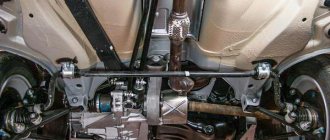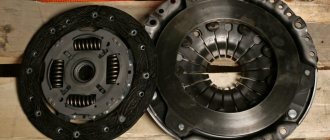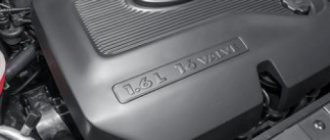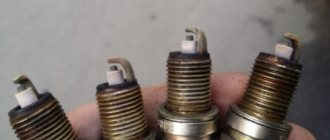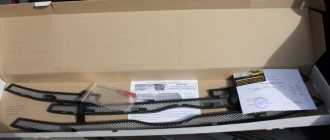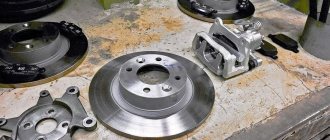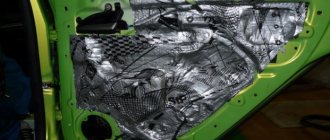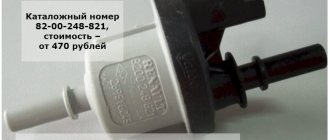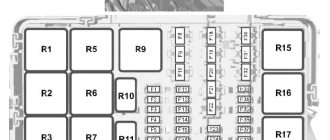The front and rear suspension of Vesta differs significantly from the one that AVTOVAZ used on Grant, Priora, Kalina, etc. All the reviews tell us that the new chassis design is better than before. However, during the first months of operation, the owners began to notice extraneous noises (knocks, creaks, rattles, crunches) in the front and rear suspensions of Vesta, which occur when driving over speed bumps or other road irregularities...
Grinding, creaking in the front suspension
A dull sound, as if the racks are touching the plastic, or a creaking sound reminiscent of rubber friction. The reason is the poor quality of the stabilizer bushings (No. 8) or insufficient lubrication of the muffler mounts.
Question to AvtoVAZ: When will the problem of squeaking bushings be resolved? New cars from October-November continue to creak.
Answer: Improvements were introduced (replacement of rubber, lubricant) at the end of November 2016.
09 February 2016 LadaOnline 100 407
The front and rear suspension of Vesta differs significantly from the one that AvtoVAZ used on Grant, Priora, Kalina, etc.
All the reviews tell us that the new chassis design is better than before.
However, during the first months of operation, the owners began to notice extraneous noises (knocks, creaks, rattles, crunches) in the front and rear suspensions of Vesta, which occur when driving over speed bumps or other road irregularities...
The engine is the holy of holies of any car, and therefore, when extraneous sounds begin to be heard from under the hood, car owners immediately sound the alarm and try to figure it out.
Problem
As sad as it is to realize, West owners are not spared this problem either. Many owners notice knocking noises under the hood of the Lada Vesta, and they come from the right side.
As a rule, you don’t have to search for long, since the situation is well known. It appears on sedans that were equipped with engine mounts from the VAZ 21129. As a result, a whole cacophony of sounds began to be heard from the engine compartment, including knocks, clicks, squeaks, etc. Moreover, these sounds are so loud that they can be heard even in the cabin.
The knock from the support is quite loud
And the best confirmation of this is numerous videos in which owners of the domestic model demonstrate trouble.
And in this video you can hear knocks directly inside the car.
In addition, some owners began to “dig deeper” and found out that a similar situation occurs not only on Vesta, but also on other models of the Renault-Nissan Alliance. In particular, on the Nissan Qashqai. This is also confirmed in the video.
As for the Lada X-Ray, the hatchback has not noticed such a problem, even though its engines are the same as those on the sedan. The whole point is that X-Ray is equipped with different supports for the power unit.
Solution options
In fact, there are several of them.
In the event of a visit to the dealer, there is, as a rule, no clear solution to the issue of knocking from under the hood of the Lada Vesta. It all depends on the specific salon.
Some centers simply refuse to replace them, citing the fact that this is not a warranty case.
Others sent information about the defect directly to AvtoVAZ, but this is a rather lengthy procedure, and therefore not everyone agrees to wait that long. And the answer is not always positive.
Many dealers refuse to replace the airbag under warranty.
However, some owners note that they had reinforced supports installed, after which the problem disappeared.
The time that has passed since the first Lada Vesta rolled off the AvtoVAZ assembly line was quite enough for the owners to leave objective reviews about this car. In particular, readers are interested in the reliability and maintainability of the front and rear suspension. Vesta's handling has truly become a legend.
Even many skeptics were forced to admit the fact that the domestic auto industry had finally provided a model capable of competing with budget versions of German and Korean manufacturers.
The fly in the ointment in the overall picture is periodic complaints about extraneous noises and knocks that appear at fairly low mileage rates.
On the other hand, there are unpleasant facts when specialists and representatives of the official dealer are engaged in elementary “pumping out funds” without finding the cause of the malfunction.
Therefore, the basics of basic suspension diagnostics and the possibility of self-repair should be known to the owner of a domestic car, at least for now.
Even an amateur can recognize extraneous noises that appear in his own car, because an unfamiliar sound is always clearly audible against the background of the familiar “ensemble.”
Knocks and noises in the chassis of the car should not plunge the owner into a state of shock, because all components are repairable, but it is necessary to urgently diagnose and fix problems, since the condition of the suspension is not only driving comfort, but also road safety.
Extraneous noise can be produced by rubber with a hard tread or with a broken cord. A wheel bearing that has become unusable has similar symptoms. During the off-season, the accumulated dirt that gets between the brake disc and pads disturbs the ears.
Knocks have a different nature and appear in different situations. The cause of such an unpleasant phenomenon may be a faulty stabilizer link or bushing, a failed ball joint or support bearing. Let us analyze in detail the diagnostic methods and methods for troubleshooting the Lada Vesta.
If an inexperienced driver does not notice such a malfunction immediately, then over time he will still have to think about diagnostics, since this noise increases all the time.
In particularly advanced cases, the whine of the bearing can be heard in the cabin and can drown out other sounds.
Diagnostics
In order to make sure that the bearing is faulty, and at the same time determine from which side the sound is coming, it is enough to accelerate on the highway to 50 km/h, make sure that there are no other road users in front or behind, and make oscillating movements of small amplitude with the steering wheel while steering the car then to the right, then to the left.
When it rotates, a noise is heard - change the bearing.
View full version : Steering wheel tapping during small irregularities
There were knocking noises when driving over small irregularities! especially noticeable on crushed stone! The knocking is not constant and apparently at a certain steering wheel position! It was the same on both Kalina and Grant! nothing changed! :pissed-off: does anyone know what to do with this?
Mishanya
15.05.2016, 15:22
I know: find out what is knocking and replace it with something that doesn't knock! And if the car is still under warranty, provide this action to the service center.
The rack taps. Apply for warranty!!!
still for people
Posts 1 to 25 of 63
1 Topic from Pluto 2016-03-30 07:25:38 (2018-03-22 02:46:55 edited by Pluto)
Subject: Knocking noise from front left
Has anyone encountered this problem, please tell me what it could be. When driving through potholes with sharp edges, a dull clanging sound is heard from below on the left, reminiscent of the knock of an unscrewed disk on the hub. The sound is best noticeable at low speed when driving in 1st or 2nd gear. Then it just gets muted. The defect occurred immediately after purchase. A visit to the dealer revealed nothing.
Currently, AVTOVAZ produces standard polyurethane bushings for Vesta. The stabilizer does not creak in them.
Outdated information: (I decided to collect information (from the Internet) on stabilizer bushings and struts that fit us. Correct, add, I’ll post it here.
Struts: Renault 54 61 800 02R (274 mm) or 8200 669 065 (283 mm) lemforder 3710901 Bushings: Chevrolet Niva (2123-2906046R?) (small) install without cutting with soap>
2 Reply from Petty 2016-03-30 08:10:00
- Petty
- Participant
- Inactive
- Messages: 966
- Thank you: 271
Re: Knocking noise from front left
Has anyone encountered this problem, please tell me what it could be. When driving through potholes with sharp edges, a dull clanging sound is heard from below on the left, reminiscent of the knock of an unscrewed disk on the hub. The sound is best noticeable at low speed when driving in 1st or 2nd gear. Then it just gets muted. The defect occurred immediately after purchase. A visit to the dealer revealed nothing.
3 Reply from d.PO 2016-03-30 14:07:10
Re: Knocking noise from front left
The defect occurred immediately after purchase. A visit to the dealer revealed nothing.
But did they listen to the knock? what and how did you check? Did you do any broaching at all?
4 Reply from Pluto 2016-03-30 22:27:54
Re: Knocking noise from front left
We stretched out the subframe and everything we could reach from below. We shook the ball joint and hub, and the stub drains. They also seem to have rocked the steering tips. They spread their hands. Today I looked down and there are a lot of nuts and bolts on the subframe. I would have to stretch them all out. The most interesting thing is that when you rock the car in a parking lot, nothing rattles, but on sharp potholes, yes. Maybe the shock absorber is defective, but how can you tell?
5 Reply from Pluto 2016-03-31 22:08:55
Re: Knocking noise from front left
Today I remembered all the problems again and went to the dealer. The source of the sound has been identified. This is the knocking of the anti-roll bar. His lateral movement limiter is faulty, as I understand it. The defect was recognized as covered by warranty. They will change the stabilizer as soon as a new one arrives. Will wait.
6 Reply from Axel 2016-04-02 08:30:11
- Axel
- Participant
- Inactive
- Messages: 973
- Thank you: 139
Re: Knocking noise from front left
The source of the sound has been identified. This is the knocking of the anti-roll bar. His lateral movement limiter is faulty, as I understand it. The defect was recognized as covered by warranty. They will change the stabilizer as soon as a new one arrives. Will wait.
It won't last long. We need to install something else, better quality.
7 Reply from Pluto 2016-04-02 13:28:42 (2016-04-02 13:31:24 edited by Pluto)
Re: Knocking noise from front left
It won't last long. We need to install something else, better quality.
What, have you already had experience replacing the stabilizer?
8 Reply from Dimidrol 2016-04-03 01:31:28 (2016-04-03 02:04:44 edited by Dimidrol)
Re: Knocking noise from front left
Looks like I have the same problem. I went to the officials, but of course they didn’t find anything. What does this limiter even look like, how was it diagnosed?
9 Reply from Axel 2016-04-03 07:04:40
- Axel
- Participant
- Inactive
- Messages: 973
- Thank you: 139
Re: Knocking noise from front left
What, have you already had experience replacing the stabilizer? ai
So they exchange it for the same one. That means the new one will knock too.
10 Reply from Pluto 2016-04-03 23:15:44
Re: Knocking noise from front left
Looks like I have the same problem. I went to the officials, but of course they didn’t find anything. What does this limiter even look like, how was it diagnosed?
I didn’t catch up with the diagnostic process, so I gave the car away for half a day through a personal manager. They found it themselves. I rummaged through the technological instructions (https://yadi.sk/d/zTESYkz0mDbKY; https://yadi.sk/i/jd13nycwoyZVi links from the documentation section) and, as I understood from the explanations, the “belt on the stabilizer bar” fig. 7-2. You can look at it using a mirror. To be honest, I haven’t looked at it myself, but I’ll look in soon. It's a very uncomfortable place - behind the steering rack. By the way, such a knock could have occurred on the right side if the belt had broken on the other side. Honestly, this defect ruined the whole impression of the car.
11 Reply from Pluto 2016-04-03 23:28:52
Re: Knocking noise from front left
So they exchange it for the same one. That means the new one will knock too.
What a pessimist. There is a separate topic for flooding. If the new one knocks, I’ll weld a nut instead of a belt and that’s it!
12 Reply from antifashist 2016-04-05 15:05:12
- anti-fascist
- Moderator
- Inactive
- From: Salavat, Bashkortostan
- Messages: 708
- Thank you: 73
Re: Knocking noise from front left
It may not knock. There was simply a manufacturing defect in the parts.
13 Reply from Pluto 2016-04-12 00:18:56
Re: Knocking noise from front left
The stabilizer was replaced. The new one is no different from the old one.
The problem, they say, is in the soft split bushings of the stabilizer. We modified the stabilizer in place with a heat-shrink tube. Reassembled with grease and sealant. Now it doesn't seem to knock. The manager assured that the modification was effective. But cars with different stabilizer bushings are now coming off the assembly line. In fact, it is not clear why the bushing is split? They have less rigidity. In this regard, the question is: what can be replaced? maybe from Moskvich-2141 along with a bracket? If anyone has the opportunity to measure and compare, please share your experience.
14 Reply from hufsa 2016-04-12 07:08:30 (2016-04-12 07:13:03 edited by hufsa)
Re: Knocking noise from front left
There is also a rattling sound. Maybe you can add something to this belt? The dealer didn't find anything. Is there any way to diagnose this yourself?)
15 Reply from Pluto 2016-04-12 22:09:31
Re: Knocking noise from front left
In this whole story, 2 circumstances confuse me: - I hear clanking only on the left, there is none on the right, but the stabilizer is symmetrical. - again a subjective opinion - the rattling seems to have remained, but it has become muffled and less noticeable.
I came to the thought that a knocking noise occurs when the wheel moves suddenly, maybe it’s the belt itself (the gray rings in the photo) knocking on the subframe or the hub bracket? I myself have not yet been able to crawl under the car to inspect the heat-shrinkable tube, which they put on me in such a way that it overlaps the belt and sleeve. The bushing cut was sealed with sealant.
You can try to diagnose it this way: disconnect the stabilizer link from the stabilizer itself on one side. Strongly shake up and down the free edge of the stabilizer.
For all questions, it is better to contact your personal manager rather than the dealer. They are on top of this issue.
16 Reply from hufsa 2016-04-13 07:03:36 (2016-04-13 07:09:06 edited by hufsa)
Problems with noise and squeaking from the rear of the car
The increasing grinding noise of the front suspension of the Lada Vesta is especially worrisome, because the main load is concentrated here, the steering and braking systems are located, the condition of which must always correspond to the norm.
A front-wheel drive car, as in our case, is prone to problems with the nose.
Inspection of the front suspension.
The very first cause of the malaise is considered to be an unfinished design of polyurethane stabilizer bushings, which almost immediately begin to make groaning sounds when driving through plump speed bumps. In wet weather he begins to moan constantly, which is very exhausting.
This problem can be corrected in several ways, radical and not so radical:
- Replacement of pillows with analogues from Chevrolet Niva or other suitable foreign cars.
- Regular application of mastic to places where polyurethane rubs against metal.
- Wait until AvtoVAZ corrects the defect, inviting everyone to the service station for a replacement.
The problem with squeaks in the front suspension can be solved by replacing the stabilizer bushings with polyurethane.
What else could be wrong with stabilizers? The design has a strut that is attached to the shock absorber body and the cross member of the stabilizer itself. It has two fingers as fastening. Without diagnostics at a service station, it will not be easy to figure out whether there is a breakdown in this unit, but you can try.
Dealers replace stabilizer links free of charge. But sometimes you have to butt heads!
The problem with the struts is not far-fetched, since in April 2022, official representatives of AvtoVAZ reported that they knew that after just a few thousand kilometers Vesta was already detecting knocking and squeaking noises from this particular unit. This important element experiences special stress and wears out prematurely.
Replacement of squeaking elements at the dealer should be free of charge. All questions can be resolved by calling the hotline!
However, all car owners who complain about the performance of the struts during the warranty period will have them completely replaced at the dealership free of charge.
So, if the warranty has expired, you will have to try to solve the problem yourself. The replacement process is simple. After inspecting the removed parts, you can decide whether to replace the entire mechanism or limit yourself to a repair kit.
Quite often, extraneous squeaks are caused by brake calipers.
There are isolated cases where the following types of breakdowns have occurred over time:
- The silent blocks of the steering gear levers require replacement, which are extremely inconvenient to remove.
- Brake calipers may gradually begin to click, replacing the pins may solve this problem.
- A small play appears in the place where the strut cups are attached to the body, associated with wear on the threads of the mounting bolts.
Creaking from the rear of the car Malfunctions can also manifest themselves as a knocking sound in the rear suspension when driving over uneven surfaces or a creaking noise from the rear. All these sounds signal a problem that needs to be solved. In order to remove it, as recommended by the factory, it is necessary to cut out the gasket and install it on the upper shock absorber support. This will eliminate knocking in the Lada Vesta suspension.
Poorly spun wheels can crunch and squeak. This often occurs on other car models and is caused by the car owner’s carelessness when changing wheels. It is urgent to stop and tighten the wheels.
Poorly packed items in the trunk of a car can make knocking and crunching noises. Before trying to eliminate suspension squeaks, you should empty the trunk of all unnecessary things and drive the car.
If there are no extraneous sounds, then the issue is resolved. Sources of extraneous noise from behind can also be minor problems, but to eliminate them you need to know them:
- The handbrake cable is not secured, just tighten the tie;
- The trunk lid dampers may make different sounds; they should be lubricated with silicone grease;
- With increased play, the trunk lid begins to rattle; lubricate and eliminate the play;
- The locks of the rear seat back may squeak, just lubricate and wrap a little electrical tape;
- Things are poorly packed in the trunk.
As a rule, you don’t have to search for long, since the situation is well known. It appears on sedans that were equipped with engine mounts from the VAZ 21129. As a result, a whole cacophony of sounds began to be heard from the engine compartment, including knocks, clicks, squeaks, etc. Moreover, these sounds are so loud that they can be heard even in the cabin.
What conclusions do I want to share with those who have bought or want to buy Vesta:
- Lada still doesn’t have a warranty: they either refer you to others, deliberately making unreasonable deadlines for claiming under the warranty, or they offer to wait for months without giving any deadlines..
- The car is “crude”, many problems have not been solved in almost a year and a half, they test drive it on you and collect breakdown statistics.
- There are no spare parts for VAZ, and you have to wait even longer for them than from any foreign brand (they usually have basic spare parts within a week, but most likely they keep the same bushings in stock) - this is nonsense, because it was always believed that spare parts for Lada on every corner - today this is far from the case.
- The cost of servicing the Lada Vesta is no longer budget-friendly and is at the level of its competitors.
- Problems with the car, as before, will have to be solved not by the dealer, as you hoped, but by yourself, using your ingenuity and straight hands, or your uncle from the garage.
- Stabilizer bushings are not the only knock and creaking in Vesta’s suspension: many also encounter a bunch of others.
conclusions
If the service life of some units has come to an end, then they need to be replaced urgently, since one breakdown can lead to others, and the entire mechanism will go into disarray.
If we return a little to squeaks, then with significant fatigue of the ball joints, steering tip and rack, failure of the shock absorber, or its broken supports, unnatural irritating sounds may appear. Then it is best to go for a diagnosis and then treat the problem.
Despite the fact that a modern car is not only a high-tech vehicle and is manufactured to the most advanced standards. Even they have problems. These faults can manifest themselves as a knocking sound in the front suspension of the Lada Vesta.
Although the suspension turned out to be successful, malfunctions periodically arise, which the manufacturer analyzes and makes recommendations for eliminating squeaks in the Lada Vesta. They may appear as extraneous sounds or knocks.
Honest dealer - Bright Park
Bright Park began by deceiving me even at the stage of the telephone call: I listened to the phrase “...in a few seconds they will answer you...” I listened for more than two minutes, but when they answered me, it turned out that they knew about the problem, they offered to come in two weeks, since the repair zone is supposedly “fully occupied until this date.”
To my reasonable question, how can I drive for two weeks on a creaking suspension, what if something serious is there and something falls off, they haven’t even seen the car, they immediately stated that absolutely ALL cars have this situation (.) and nothing won’t happen (are they psychics there, can they make diagnoses over the phone?).
At the same time, when I called the second time, they were ready to make an appointment for tomorrow (that is, when for money, their repair area is empty, and when under warranty, the repair area is suddenly completely occupied for two weeks? Well, well..).
At the end of the conversation, I was even offered to contact another dealer (this is customer-centricity - to lose a client by sending him to another dealer??).
Defects of Lada
Lada Vesta has recently rolled off the assembly line and not all warranty workshops have experience in solving problems on how to eliminate knocking noises that occur in the suspension. The manufacturer constantly maintains contact with the service station and makes changes to the design. Let's consider possible malfunctions and methods for eliminating them in the front suspension of the Lada.
Car enthusiasts may be disappointed by a new car almost immediately. An unpleasant creaking and knocking sound appears when passing speed bumps. Upon analysis, it turned out that the problem was in the stabilizer bar bushings.
It is not recommended to lubricate them with grease; they will stop squeaking, but for a very short period of time, so they only need to be changed. They can be replaced with polyurethane ones from Niva Chevrolet. The bushing has catalog number 17012680. After replacement, the squeaking sound disappears.
You should know that these are not all problems; a characteristic knocking sound may occur from the front right.
This is typical when there is increased play in the right ball joint. Replacement is carried out together with the suspension arms assemblies. AvtoVAZ supplies them complete with a ball joint. Front suspension of the Lada Vesta The main defects that occur in the front part of the Vesta car, which may cause the car to creak or rattle:
- Grinding noise in the anti-roll bar;
- The right ball joint is faulty, it starts knocking;
- The stabilizer links begin to rattle.
It is recommended that all these defects be repaired at AvtoVAZ dealerships.
When driving on an uneven road, you hear a dull knock on small bumps or a sound reminiscent of rubber friction. This problem can be eliminated by lubricating the Vesta muffler mounting with grease. Vesta's front suspension creaking may be due to worn struts.
How to get rid of creaking stabilizer bushings on Lada Vesta
This scheme is incorrect, in my opinion, since it changes the characteristics of the suspension and handling of the car, since no one calculated how non-original parts would behave, and whether this would be dangerous. Nevertheless, many people are tired of driving and creaking for months.
The collective farm scheme is as follows: we remove the stabilizer bushings and the bushing mount (U-shaped bracket that holds the bushing), install bushings 54813-2K100 and bushing mount 54814-1G000 from Kia/Hyundai (you can also install them from Shnivy, but the quality is unpredictable...), they cost depending on the manufacturer (original or not original) from 600 to 3000 rubles for everything.
How the body is made
Let's admit: the Lada Vesta, which is attractive in our opinion, is very well assembled in terms of its bodywork. The measured gaps are everywhere at the level of a couple of millimeters. Well, the softness and silence with which the doors close are completely worthy of applause. And everything would be absolutely wonderful if we had not started studying the car from below.
In general, of course, there is no “crime”. The first thing that caught my eye was the sloppiness of the anti-corrosion treatment, in the category of “we’ll apply it here, but it’ll do just fine.” It can be seen that some areas were treated over the protective film, which was then torn off along with the protection. Moreover, in the same place it was done with completely different quality (carefully and clumsily).
An incident was discovered under the hood - at the factory, a piece of paper was attached to one of the side members with tape, apparently with an example of a color called “platinum”, in which it was necessary to paint the car from the inside. Actually, they painted this piece of paper, forgetting to tear it off - naturally, there was a stripe under it without painting.
Another point is the accuracy of internal bends and connections of individual body parts. Between some of them there are considerable technological holes into which, of course, dirt, salt and road chemicals will get clogged. Considering that some of these connections have not been exposed to anticorrosive agents, they are likely to become centers of corrosion, especially in the wheel arches.
↑ Which bushings are suitable
When planning how to select and change creaking stabilizer bushings on his Vesta, the car owner can take as a basis information about spare parts from Niva (article 2123-2906046, 2123-2906040) or Korean cars (KSBSOULF, 54813-2K100). The full compatibility of the products will be clear after comparing them with existing ones: you will be able to install worn liners without any problems, or you will have to slightly modify them to the required dimensions.
This issue can be resolved on your own or by contacting the nearest service center: for a small fee, specialists will modify and replace the rubber bands, while at the same time checking the condition of other components (for example, racks).
In general, the task of eliminating the causes of the unpleasant squeaking bushings in the stabilizer of the Lada Vesta car seems quite feasible: it is enough to find out the product number in order to then begin selecting analogues for replacement. The use of a lubricant, even the most advanced one, as practice shows, will do nothing: after some time, a thin layer of emulsion will inevitably be washed off and the parasitic noise will appear again. Also, unfortunately, contacting an authorized service center will be ineffective: its specialists do not consider it necessary to replace the bushings, limiting themselves to treating the rubbing units with a lubricating spray.
The optimal solution would be to replace the stabilizer bushings, and when exactly it is needed, the car owner himself can decide as soon as he hears the characteristic creaking of the suspension. You can combine the operation with maintenance or inspection of other components: it often happens that wear of shock-absorbing elements is accompanied by other minor faults.
When purchasing spare parts for replacement, you must check whether the actual characteristics correspond to the declared ones, and beware of counterfeits and obvious defects. To do this, it is recommended not to purchase goods at a deliberately reduced price, check at retail outlets for the originality of spare parts and the availability of manufacturer certificates.
By carefully selecting new earbuds and installing them correctly, you will be able to get rid of this unpleasant and annoying defect once and for all.
Self-diagnosis of problems
If there is a knocking sound in the steering wheel or the Vesta suspension rattles, you should immediately contact the dealership.
If this is not possible, you can diagnose and identify problems yourself. To do this, just hang up the Lada wheels and do the following work:
- Let's rock the wheels in different planes; if play is felt when the brake pedal is released, this indicates that the hub bearing has failed;
- If there is a problem with the suspension, play is felt regardless of whether the brake pedal is pressed or released;
- If the ball joint is defective or the strut is poorly secured, play is felt in the vertical plane;
- Failed tie rod ends are accompanied by play in the horizontal plane.
Thus, it becomes clear why the front suspension of the Lada Vesta creaks. It is not recommended to drive with such defects; if they are detected, you must contact a service station. And at the dealership they will conduct a full diagnostic of the chassis and not only give recommendations on how to eliminate the crunching sound in the front suspension, but will also carry out the repair work in a qualified manner.
Wear of stabilizer link joints
When diagnosing stabilizer bushings, as a rule, all elements of the front suspension are inspected and, first of all, the vertical struts of the anti-roll bar (article no. 8450006750), which also often fail in Lada Vesta.
Lada Vesta produces standard stabilizer bars. These parts are of fairly high quality, but they also have their own resource, which depends on many factors. The degree of wear of the vertical struts is determined by the presence of play in their hinges - if the struts knock when the stabilizer is suddenly manually moved, they need to be replaced. Knowing the length of the struts (283 mm), you can select even better parts for replacement, for example, from Toyota or Hyundai.
- socket wrench “16” - unscrewing the nut;
- Torx key 30 – pin locking.
Production of replacement racks
The work is carried out on a car lift. Replacing parts with new ones is not difficult: fix the finger with one key, and unscrew the nut with the second.
Loose wheel bolts
The situation when the fastening bolts of one or several wheels have become loose is typical not only for Lada Vesta, but occurs frequently. There can be many reasons - from inattention during tire fitting to an unsuccessful attempt to steal a wheel.
If a knocking sound occurs while driving, the first step is to perform the most accessible action - stop the car and check the tightness of the wheel bolts, since a tire that falls off while turning can cause the car to roll over with unpredictable consequences. In this case, diagnostics is inseparable from troubleshooting.
After tightening the bolts or making sure that the reason for the knocking is not their tightening, you can continue driving. If the problem is not solved, you should not put off diagnosis for a long time. In order not to aggravate the situation when one malfunction causes another, it is strongly recommended to contact an authorized dealer as soon as possible for qualified diagnosis and elimination of the causes of knocking or other abnormal suspension noises performed on a car raised by a lift.
First maintenance of Lada Vesta
What kind of work does the first maintenance for the Lada Vesta sedan consist of? This includes replacing the oil, air and cabin filters, changing the engine oil, checking the condition of the brake pads, as well as diagnosing the engine control unit using a special scanner. At the official service station of the Lada brand in Kazakhstan, German synthetic oil Rowe 5W40 was poured into the Lada Vesta of automotive journalists. It was chosen because it is officially supplied to the car showrooms of this dealer network in Kazakhstan. The Lada Vesta engine control unit was checked for errors using a special scanner, which had an interface similar to the Windows 8 operating system. This equipment is certified for the Lada Vesta model car. According to specialists from the official Lada service station in Kazakhstan, this device costs about 300,000 rubles. Fortunately, this device did not show errors in the Lada Vesta engine control unit.
This is what the error scanner looks like for the Lada Vesta engine control unit.
When lifting the Lada Vesta car onto a lift, it was immediately discovered that the winter tires of the Nokian Nordman 5 model had lost quite a lot of studs in the conditions of winter Russian roads.
Step-by-step instructions for replacing bushings
To make high-quality repairs with your own hands, you must meet some requirements: prepare the place for repairs and select the necessary tools.
Necessary tools and place of work
To perform the work, you should know the basic rule: the wheels of the car must be unloaded, that is, hanging freely in the air. The work will require a technician to be under the car, so it is better to do it on an inspection pit or a lift.
When using an inspection hole to hang the wheels, you will need a jack and stands on which the car will rest. They are not needed when working with a lift.
Tools and materials:
- M16 socket or combination wrench.
- Open-end and ring wrenches, M13 head.
- Head or combination wrench M10.
- T40 Torx key.
- A small crowbar or spudger.
- Silicone or other non-rubber-damaging lubricant.
- Rags.
Where are they installed and how to remove them
The Lada Vesta stabilizer bushings are located on the right and left sides of the front suspension subframe. They are located in front of the car's steering rack. A special feature of the Lada Vesta is that its stabilizer bar bends around the anthers of the left and right steering rods.
The lack of space for installing the stabilizer bar led to the fact that the factory designers moved its mounting points as close as possible to the steering rack. This decision greatly complicated the ability to unscrew the inner bolt securing the hub clamp. Even using a T40 wrench does not always allow you to completely unscrew this bolt.
Sequence of work when using a cut bushing:
- Place the machine on a pit or lift.
- Hang up and remove the front wheels.
- Clean the stabilizer bar from dirt along its entire length.
- Unscrew the outer bolts securing the bushing clamps.
- Unscrew the inner bolts to the maximum possible height and try to rotate the clamp around the inner bolt so that the bushing is released.
- If you cannot unscrew the inner bolt, then loosen the steering rack fastenings and lift it, or remove it completely.
- The damaged bushing is moved in any direction and simply removed if it is cut, or cut off with a sharp knife if it is not cut.
- The installation site is cleaned of possible adhering particles of rubber and dirt, wiped with a rag, and lubricated with a special lubricant.
After completing all the items on the list, the place can be considered prepared for installing a new rubber band.
Installation of new parts
If you plan to install a cut bushing, then simply put it on the rod using the cut. Then the elastic band is moved along the rod to the installation site.
Installing an uncut bushing is a little more difficult - you need to disconnect the rod from the wheel assemblies before starting work. To do this, at both ends of the rod, unscrew the nuts of the ball pins of the stabilizer struts, and, having disconnected these struts, move them to the side.
After this, you can begin installing new rubber bands. The assembly sequence is as follows:
- Lubricate the rod from the edge to the place where the bushing is installed with silicone grease.
- Place a new elastic band on the bar and slide it along the bar to the desired location.
- Close the bushings with clamps and tighten the fastening bolts (it is advisable to tighten them lightly so as not to strip the threads).
- Return the steering rack to its place.
- Stabilizer struts are attached to the edges of the rod.
It should be noted that if, when replacing the bushings for the first time, it became necessary to work with the steering rack, then in the future this need can be eliminated if the holes on the bushing clamps for the internal bolts are replaced with slots. Then to remove the clamp it will be enough to unscrew the inner bolt 2/3 of its length.
Assessment of the condition of parts after replacement
It may happen that the creaking of the bushings does not disappear in the first kilometers after repair. This is acceptable - the new rubber bands should “break in.”
Bad roads are not the best place to drive, but they provide a good way to test the quality of any repair work. If after a run of 300 km the squeak does not disappear, you should look under the car and visually evaluate the bushings. A bushing made of low-quality material, even over such a short run, will become covered with a network of cracks and, alas, will have to be replaced again.
If the appearance of the replaced bushing does not raise suspicions, then perhaps you should pay attention to the tight fit of the bushing to the stabilizer bar. The fact is that sand that gets under the rubber band “eats” not only it, but also the top layer of metal of the rod
In this case, the stabilizer bar itself must be replaced.
